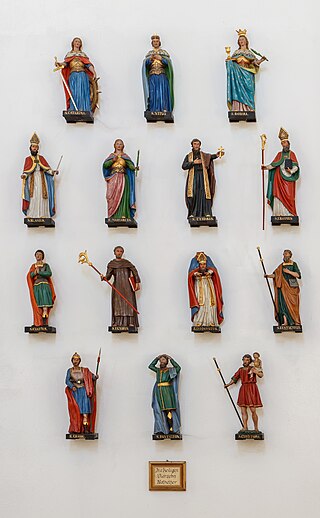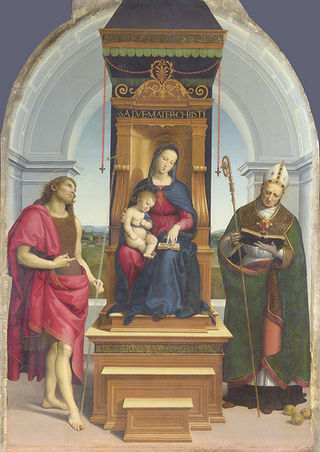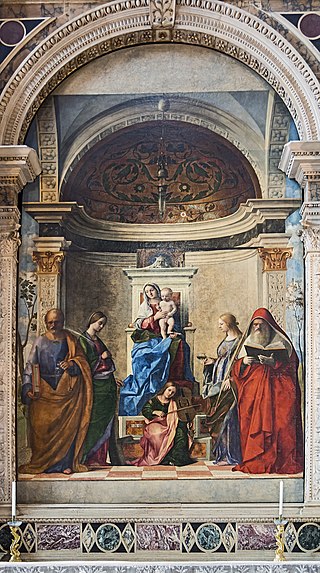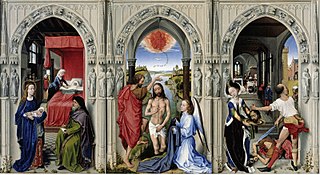Saint John Altarpiece may refer to:
Saint John Altarpiece may refer to:

Fra Angelico, O.P. was a Dominican friar and Italian Renaissance painter of the Early Renaissance, described by Giorgio Vasari in his Lives of the Artists as having "a rare and perfect talent". He earned his reputation primarily for the series of frescoes he made for his own friary, San Marco, in Florence, then worked in Rome and other cities. All his known work is of religious subjects.

An altarpiece is an work of art in painting, sculpture or relief representing a religious subject made for placing at the back of or behind the altar of a Christian church. Though most commonly used for a single work of art such as a painting or sculpture, or a set of them, the word can also be used of the whole ensemble behind an altar, otherwise known as a reredos, including what is often an elaborate frame for the central image or images. Altarpieces were one of the most important products of Christian art especially from the late Middle Ages to the era of Baroque painting.

The Ghent Altarpiece, also called the Adoration of the Mystic Lamb, is a very large and complex 15th-century polyptych altarpiece in St Bavo's Cathedral, Ghent, Belgium. It was begun around the mid-1420s and completed by 1432, and it is attributed to the Early Netherlandish painters and brothers Hubert and Jan van Eyck. The altarpiece is a prominent example of the transition from Middle Age to Renaissance art and is considered a masterpiece of European art, identified by some as "the first major oil painting."

Domenico di Tommaso Curradi di Doffo Bigordi, professionally known as Domenico Ghirlandaio, was an Italian Renaissance painter born in Florence. Ghirlandaio was part of the so-called "third generation" of the Florentine Renaissance, along with Verrocchio, the Pollaiolo brothers and Sandro Botticelli.

The Fourteen Holy Helpers are a group of saints venerated together by Catholics because their intercession is believed to be particularly effective, especially against various diseases. This group of Nothelfer originated in the 14th century at first in the Rhineland, largely as a result of the epidemic that became known as the Black Death.

Carlo Crivelli was an Italian Renaissance painter of conservative Late Gothic decorative sensibility, who spent his early years in the Veneto, where he absorbed influences from the Vivarini, Squarcione, and Mantegna. He left the Veneto by 1458 and spent most of the remainder of his career in the March of Ancona, where he developed a distinctive personal style that contrasts with that of his Venetian contemporary Giovanni Bellini.

The Basilica Metropolitan Cathedral of Lima and Primate of Peru, otherwise Lima Metropolitan Cathedral, is a Roman Catholic cathedral located in the Plaza Mayor of downtown Lima, Peru. This third and current Cathedral of Lima was built between 1602 and 1797. It is dedicated to St. John, Apostle and Evangelist.

The Madonna and Child with St. Anne or Madonna and the Serpent, is one of the mature religious works of the Italian Baroque master Caravaggio, painted in 1605–1606, for the altar of the Archconfraternity of the Papal Grooms in the Basilica of Saint Peter and taking its theme from Genesis 3:15. The painting was briefly exhibited in the parish church for the Vatican, Sant'Anna dei Palafrenieri, before its removal, due to its unorthodox portrayal of the Virgin Mary. There are a lot of reasons why the piece may have been removed, such as the nudity of the child Jesus and the Virgin Mary revealing too much of her breast. The reputation of the model that Caravaggio used to portray the Virgin Mary could be another reason as to why this altarpiece was withdrawn. The altarpiece was sold to Cardinal Scipione Borghese and now hangs in his palazzo.

The Isenheim Altarpiece is an altarpiece sculpted and painted by, respectively, the Germans Nikolaus of Haguenau and Matthias Grünewald in 1512–1516. It is on display at the Unterlinden Museum at Colmar, Alsace, in France. It is Grünewald's largest work and is regarded as his masterpiece.

The Ansidei Madonna is a 1505–1507 painting by the Italian High Renaissance artist Raphael, painted during his Florentine period. It shows the Blessed Virgin Mary sitting on a wooden throne, with the child Christ on her lap. On her right John the Baptist stands, on her left Saint Nicholas is reading.

The Maestà, or Maestà of Duccio, is an altarpiece composed of many individual paintings commissioned by the city of Siena in Tuscany in 1308 from the artist Duccio di Buoninsegna and is his most famous work. Duccio's the Maestà was originally composed with a front and back side that relied on each other to encompass the full knowledge of the altarpiece. This was the first altarpiece to contain both a front and back side. The front panels make up a large enthroned Madonna and Child with saints and angels, and a predella of the Childhood of Christ with prophets.

Nottingham alabaster is a term used to refer to the English sculpture industry, mostly of relatively small religious carvings, which flourished from the fourteenth century until the early sixteenth century. Alabaster carvers were at work in London, York and Burton-on-Trent, and many probably worked very close to the rural mines, but the largest concentration was around Nottingham. This has led to all the English medieval output being referred to as "Nottingham alabaster".

The Magdalen Reading is one of three surviving fragments of a large mid-15th-century oil-on-panel altarpiece by the Early Netherlandish painter Rogier van der Weyden. The panel, originally oak, was completed some time between 1435 and 1438 and has been in the National Gallery, London since 1860. It shows a woman with the pale skin, high cheek bones and oval eyelids typical of the idealised portraits of noble women of the period. She is identifiable as the Magdalen from the jar of ointment placed in the foreground, which is her traditional attribute in Christian art. She is presented as completely absorbed in her reading, a model of the contemplative life, repentant and absolved of past sins. In Catholic tradition the Magdalen was conflated with both Mary of Bethany who anointed the feet of Jesus with oil and the unnamed "sinner" of Luke 7:36–50. Iconography of the Magdalen commonly shows her with a book, in a moment of reflection, in tears, or with eyes averted.

The San Zaccaria Altarpiece is a painting by the Italian Renaissance painter Giovanni Bellini, executed in 1505 and located in the church of San Zaccaria, Venice.

The San Giobbe Altarpiece is a c. 1487 altarpiece in oils on panel by the Venetian Renaissance painter Giovanni Bellini. Inspired by a plague outbreak in 1485, this sacra conversazione painting is unique in that it was designed in situ with the surrounding architecture of the church, and was one of the largest sacra conversazione paintings at the time. Although it was originally located in the Church of San Giobbe, Venice, it is now in the Gallerie dell'Accademia in Venice after having been stolen by Napoleon Bonaparte.

Virgin and Child with Saints, is a large mid-15th century oil-on-oak altarpiece by the early Netherlandish painter Rogier van der Weyden. The work is lost since at least the 17th century, known only through three surviving fragments and drawing of the full work in Stockholm's Nationalmuseum by a follower of van der Weyden. The drawing is sometimes attributed to the Master of the Drapery Studies.

The Saint John Altarpiece is triptych of c. 1455 in oils on oak panel by the Early Netherlandish painter Rogier van der Weyden, now in the Gemäldegalerie, Berlin. The triptych is linked to the artist's earlier Miraflores Altarpiece in its symbolic motifs, format and intention.

The Pesaro Altarpiece is an oil-on-panel painting by the Italian artist Giovanni Bellini, dated to some time between 1471 and 1483. It is considered one of Bellini's first mature works, though there are doubts on its dating and on who commissioned it. The work's technique is not only an early use of oils but also of blue smalt, a by-product of the glass industry. It had already been used in the Low Countries in Bouts' 1455 The Entombment, but this marked smalt's first use in Italian art, twenty years before Leonardo da Vinci used it in Ludovico il Moro's apartments in Milan in 1492. Bellini also uses the more traditional lapis lazuli and azurite for other blues in the work.

The 1476 Altarpiece or San Domenico Altarpiece is a 1476 tempera and gold on panel altarpiece by the Italian Renaissance painter Carlo Crivelli. Its central panel of the Pietà is now in the Metropolitan Museum of Art in New York, whilst the other nine are now in the National Gallery, London.
The Saint Barbara Altarpiece may refer to: